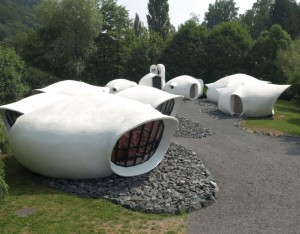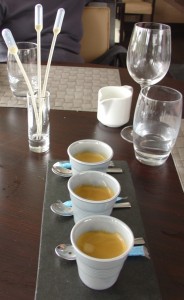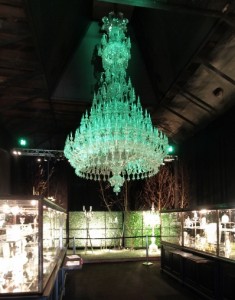To download a printable Adobe Acrobat version click on this link E2EYr9Weeks1-17.pdf (four A4 pages). Clicking on a photo will take you to a larger single image.
On Sunday mornings here there are always long queues at the bakeries, – not just for the daily baguettes but also for the beautiful patisseries. Usually we refrain from indulgence, but I have to admit to a soft spot for almond croissants. So one July morning when John and I had headed off to Saint Dié for routine blood tests (before any food) we decided to treat ourselves. None of the bars seemed to still be serving croissants, so we walked on to the Cassis Framboise boulangerie which has the virtue of snacking sur place. The décor is as pink as the name suggests and their almond croissants are even more enjoyable accompanied by orange juice, coffee, chocolate and newspapers. On the way, we paused. Rodin’s large statue of the Thinker seemed to have landed just opposite the town hall. Were we dreaming? The newspaper in the café confirmed that it was the beginning of an important summer exhibition in Saint Dié celebrating 20th century sculpture.
It is a family joke that the weather is always fine whenever John’s sister Ann and her husband Derek visit (just as it always rains when Leila is here). But the tables were turned this year. So when it was pouring with rain on Ann and Derek’s last day here in mid-August, Ann suggested that we should go out to a teashop and treat ourselves. St Die on a wet day is a dreary place, so we decided against the Cassis Framboise and the wet statues. And the Museumotel (see below) don’t do cakes. Ann was sad to hear that our favourite Gilg cake shop in Munster (where the storks nest on the town hall roof-top) had stopped serving coffee and cakes and now just sells over the counter. So she suggested a garden centre. But the combination of cakes, coffee, plants and garden furniture doesn’t seem to appeal round here. We couldn’t think of anywhere picturesque enough to justify a wet drive. In the end we joined the queue at the Saulcy (next village) bakery and came home with a wonderful selection of cakes, made our own coffee and struggled with a 1,000 piece jigsaw, appropriately Renoir’s Les parapluies. We didn’t finish the puzzle before they left, but the cakes were great (and, a week or so we later found the puzzle had one missing piece).
As you may have gathered from previous newsletters, the old people’s monthly reunion in Entre-deux-Eaux is notable for its birthday cakes and champagne, which punctuate the tarot, belote, scrabble and gossip. So there was some discussion in May as to whether I should take along a shop cake or a home-made English cake. The favourite at the gathering is gateau St Honoré (named, Wikipedia informs me, after the French patron saint of bakers and pastry chefs). In the end John kindly baked me one of my favourites, a coffee cream sponge, and I hoped people would overcome their negative attitude to British cuisine. After some discussion, Madame la presidente decided that it was the same as a French gâteau génois, and so would be safe to try. The absent John (who still insists he is too young for the club) received many compliments on his gâteau génois, and then everyone had a slice of St Honoré, just to make sure.
On my birthday itself (having already celebrated early in Portugal), we decided to try out Le Royal Chinese restaurant in St Die with Leila, Roger and Dorinda They do an eat-as-much-as-you-can buffet lunch there, and whoever thinks French men (like French women) don’t get fat would soon get proof to the contrary there, watching large men gorge themselves on the buffet à volonté. We, however, chose from the menu. The surprise came at the end. No, it wasn’t more cake, but unsolicited fire-water (sake?), served in small china cups, – pink for ladies and blue for men. At the bottom of each cup was a very rude picture.
“Interesting” cups, this time more stylish, came up in conversation while Ann and David Hart were with us in June, and led to an interesting expedition. They had driven from Nottingham to Oberammergau to see the passion play, had spent several days exploring along the Alpine Strasse, and were returning via Munich and Entre-deux-Eaux. Over breakfast on the balcony (we had hot weather for them) David was telling us about the museum of modern design in Munich and the fascinating items we all remembered from the sixties and seventies (now museum pieces) like stacking cups. John produced his Thomas stacking cups from that era, and we reminisced. Then we remembered a website John had come across which showed igloo-like white “bubbles”, built in 1967 by the utopian and visionary architect Pascal Hausermann in nearby Raon l’Etape. They have recently been restored by enthusiasts with period furnishings, and are open as a small hotel and café, the Museumotel.
As we had never seen them, we decided to go and have coffee there. We set out in the Harts car, with the roof down, and Ann and I looking appropriately in-period (well, perhaps more fifties) with head-scarves, sun hats and dark glasses. It took a bit of finding, on its little island at the end of a narrow back street. But then it was stunning. We spent some time exclaiming over the exhibition of sculpture in the reception bubble (made mainly from tools and garden implements like secateurs), and then one of the enthusiasts offered to show us some bedrooms. Inside the egg-shaped Panton bubble (dedicated to designer Verner Panton) the décor was orange and purple with large spots. Remember those psychedelic days? The greens and whites (and view of the stream) of the chlorophyll bubble were considerably more restful. The Zen bubble would probably have been relaxing too, but we couldn’t see into that one. And after all that it was far too hot for coffee, so we had long cool fruit drinks (with straws, of course) and returned through cool woods via the cool abbey church at Etival Clairefontaine.
Cups also featured in our farewell meal with the Harts at the Belle Vue restaurant at Saulxures. We’d had a leisurely lunch, very filling, on the terrace. Then the traditional coffee at the end of the meal was brought to each person in two glass cups on a wooden tray, enabling comparison between arabica and robusta. An interesting and considerably more sedate finale than the Royal’s. While Leila was with us we’d also eaten at the Cote du Lac north of Strasbourg. The food is often presented in a quirky way there. Leila’s starter, for example came in a hamburger box, and our coffee (in white china handle-less cups looking like plastic beakers for machine-coffee) was accompanied by transparent straw-like things (or pipettes) surmounted by bubbles from which you could suck small quantities of alcohol.
It’s beginning to look as if we spent the whole of May, June, July and August eating cakes and drinking coffee and spirits. But we did indulge in a bit of culture while Ann and Derek were with us. One day we headed north to Baccarat, famous mainly for its crystal production. On the other side of the river Meurthe, commanding a good view from a fortified escarpment is a small village, Deneuvre (c. 600 inhabitants, known as Danubriens). The Romans of course appreciated its strategic position. In the seventies a local farmer hired a water diviner to locate sources of streams for his cattle. And that was when, all around the now submerged sources, one of the largest sanctuaries devoted to Hercules started to be uncovered. The finds are all in a modern museum, laid out in a partial reconstruction.
So we had fun looking at that, followed by a walk along the ramparts and out to the original site (which looked like unkempt pasture once more). We paused for a very filling snack – a meal really – at a kebaberie back in Baccarat, then crossed a new footbridge over the river Meurthe to the new jewellery museum (rather boring) and went on to the crystal glass museum. We’d all been there before, but it was interesting to see again the film of crystal glass making, and then we went on to the chapel for their special exhibition – the crystal forest. If you’ve ever thought of buying a 230 light crystal chandelier, there is a magnificent one in the centre of the otherwise dark chapel, shedding green light on the crystal deer, hare, woodpeckers and ferns below.Sadly, none of our visitors, apart from Leila and Alistair were here for the Sunday flea markets. Leila rather liked a turquoise porcelain cat at one of the flea markets and predicted it would be very pricey. At 100 euro we didn’t invest. We looked more seriously at glass cake stands (alas, not Baccarat crystal), but in the end bought a pretty ring of candle holders surrounded by iron deer. We really look for bargains, so another fancied item that we didn’t buy was a 30 euro ceramic rhinoceros which could have rampaged happily in our garden. Our meagre haul this year also includes a wisteria, some fish paté dishes, a cow milk jug, a small ceramic boat for the garden wall and John’s bargain 20 cent TV aerial. This is John’s insurance measure for when the transmitter on top of the hill above Entre-deux-Eaux church is removed. Grants for the purchase of a new box are available, but one might need to produce the old aerial, which we no longer have. Some of the flea markets can be a bit lacking in atmosphere, sited on fields outside the village or on a football pitch with a handy pavilion for the firemen to cook chips and barbecue sausages and pork chunks. So we were delighted last week to come across a small village with stalls along the main winding street. The food (and you could have a whole meal here) was all being cooked in what looked like someone’s tiny front garden, and we sat at tables alongside the road, among the stalls, to eat our chips and ketchup. A loud French group behind us had a lot of empty wine bottles by their plates, and next to us were two Dutch walkers with their rucksacks. All very jolly. Today we have almost doubled this year’s haul with a Grand Marnier ashtray (labelled Grindley, England but identical to local Lunéville faience ones), an old Bakelite camera for John’s collection, and a mouli. To allow testing of the latter I picked a bucketful of plums when we got back, and John has been busy since separating quantities of stewed plums from their stones.
Alistair did very well at one of our local flea markets when he came over to help John with DIY projects last year. Sadly, this year he and John were too busy making the most of the masonry drill hired over the weekend, to have time for flea markets. The two of them worked flat out for seven days in June and the results were magnificent. We now have a new fence and gate with posts firmly cemented into a concrete base round the vegetable plot (or potager when I’m being posh), the kitchen has been re-roofed, a drain has been laid in the concrete in front of the back door, and a huge expanse of concrete now links the two terraces at the back which were different levels (paving slabs to be laid at a later date). John’s cement mixer was very busy and they managed to get through 14 bags of cement and one and a half huge bags of sand which had been winched off the delivery lorry, along with pallets of roof tiles and metal grids, the previous week. Thanks, Alistair, for all the hard work – only sorry there was no fun, not even the fireworks and bonfire at Saulcy, just solid labour, beer, exhaustion, food, Wimbledon and world cup football!
The other major project this year, to counteract the concrete expanses, was reclaiming one of our fields for John to start planting trees – referred to rather grandiosely as his arboretum, though there is little scientific study involved. Perhaps it was inspired by Brother Simeon’s garden at Autrey Abbey, – certainly the red oak saplings were found on the way home from there. So far a ginkgo, some willows and some hazels seem to have taken, whilst birches and pines which grow prolifically all around appear to have given up. An intricate network of mown paths links the planting spots (John calculates that if you walked each path, which probably involves some repetition, the distance would total a kilometre). Maybe it will need another forty years before we see it flourishing. Certainly the local wisdom (i.e. ex-farmer Duhaut) is that we won’t get to enjoy it, so it’s a bit pointless. Keep reading!




